MITSUBISHI COLT 2008 Owner's Manual (in English)
Manufacturer: MITSUBISHI, Model Year: 2008, Model line: COLT, Model: MITSUBISHI COLT 2008Pages: 450, PDF Size: 14.57 MB
Page 181 of 450
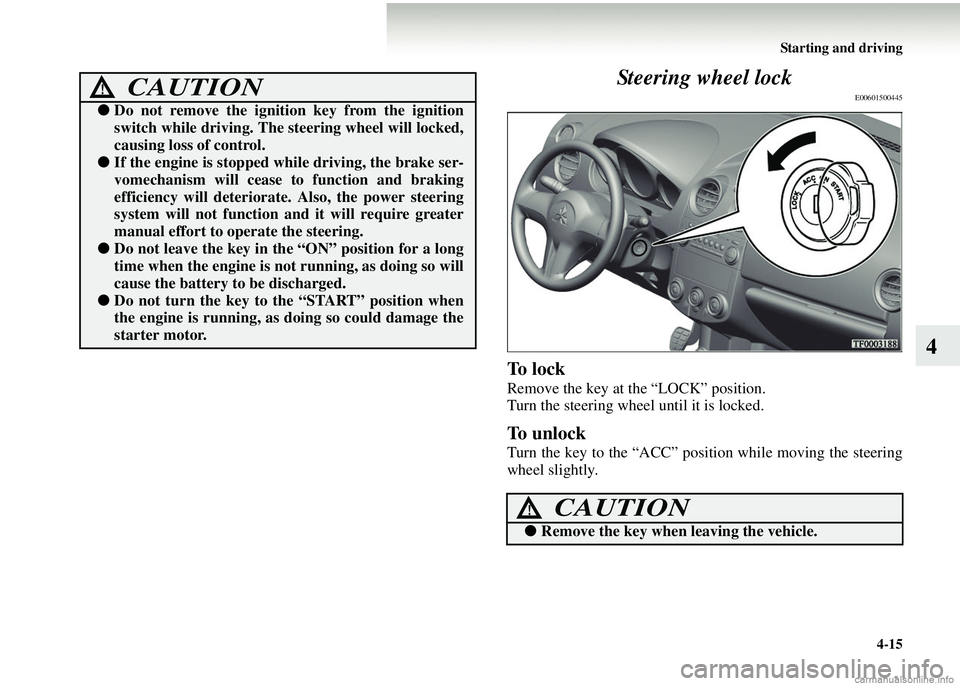
Starting and driving4-15
4
Steering wheel lock
E00601500445
To l o c k
Remove the key at the “LOCK” position.
Turn the steering wheel until it is locked.
To unlock
Turn the key to the “ACC” position while moving the steering
wheel slightly.
CAUTION!
●
Do not remove the ignition key from the ignition
switch while driving. The steering wheel will locked,
causing loss of control.
●If the engine is stopped while driving, the brake ser-
vomechanism will cease to function and braking
efficiency will deteriorat e. Also, the power steering
system will not function and it will require greater
manual effort to operate the steering.
● Do not leave the key in the “ON” position for a long
time when the engine is no t running, as doing so will
cause the battery to be discharged.
●Do not turn the key to the “START” position when
the engine is running, as doing so could damage the
starter motor.
CAUTION!
●Remove the key when leaving the vehicle.
Page 182 of 450
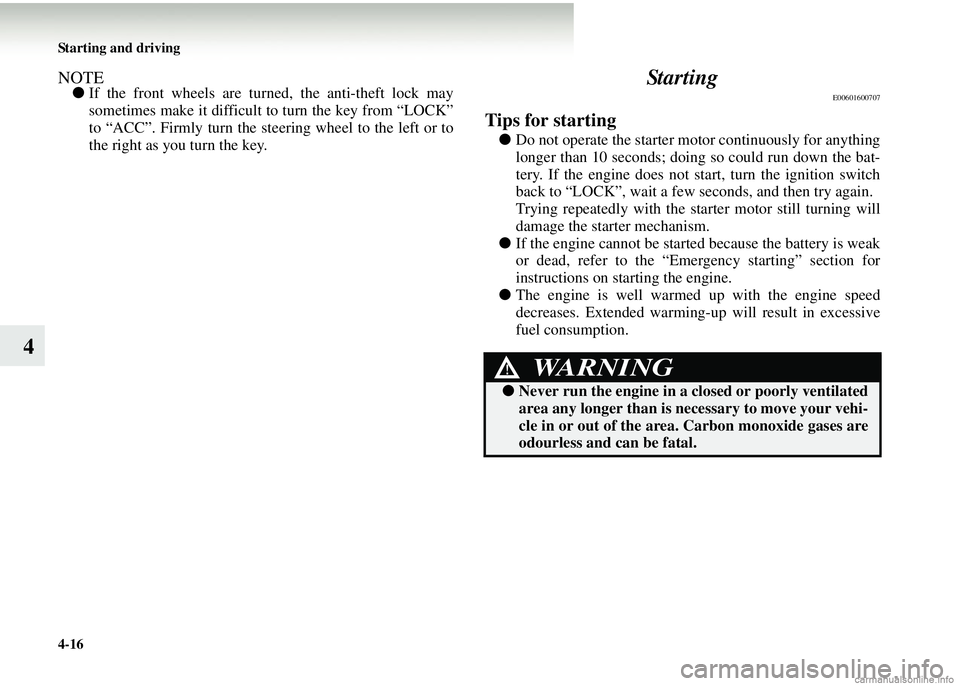
4-16 Starting and driving
4
NOTE●If the front wheels are turned , the anti-theft lock may
sometimes make it difficult to turn the key from “LOCK”
to “ACC”. Firmly turn the steer ing wheel to the left or to
the right as you turn the key.Starting
E00601600707
Tips for starting
● Do not operate the starter motor continuously for anything
longer than 10 seconds; doing so could run down the bat-
tery. If the engine does not start, turn the ignition switch
back to “LOCK”, wait a few seconds, and then try again.
Trying repeatedly with the starter motor still turning will
damage the starter mechanism.
● If the engine cannot be starte d because the battery is weak
or dead, refer to the “Emergency starting” section for
instructions on starting the engine.
● The engine is well warmed up with the engine speed
decreases. Extended warming-up will result in excessive
fuel consumption.
WARNING!
● Never run the engine in a cl osed or poorly ventilated
area any longer than is necessary to move your vehi-
cle in or out of the area. Carbon monoxide gases are
odourless and can be fatal.
Page 183 of 450
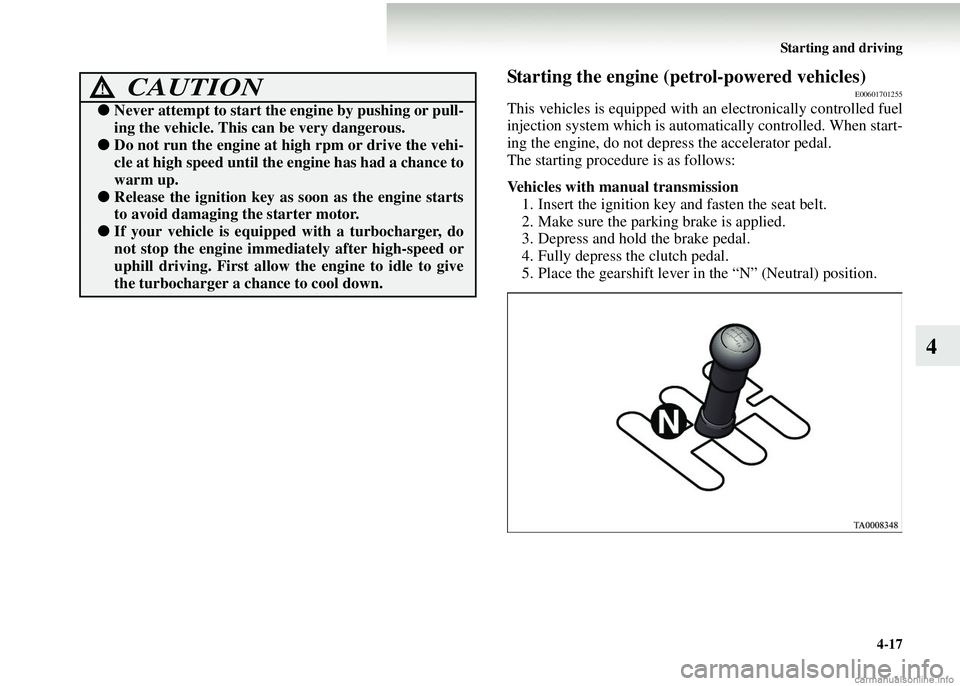
Starting and driving4-17
4
Starting the engine (petrol-powered vehicles)E00601701255
This vehicles is equipped with an electronically controlled fuel
injection system which is automa tically controlled. When start-
ing the engine, do not de press the accelerator pedal.
The starting procedure is as follows:
Vehicles with manual transmission 1. Insert the ignition key and fasten the seat belt.
2. Make sure the parking brake is applied.
3. Depress and hold the brake pedal.
4. Fully depress the clutch pedal.
5. Place the gearshift lever in the “N” (Neutral) position.
CAUTION!
●Never attempt to start the engine by pushing or pull-
ing the vehicle. This can be very dangerous.
●Do not run the engine at high rpm or drive the vehi-
cle at high speed until th e engine has had a chance to
warm up.
● Release the ignition key as soon as the engine starts
to avoid damaging the starter motor.
●If your vehicle is equipped with a turbocharger, do
not stop the engine immedi ately after high-speed or
uphill driving. First allow the engine to idle to give
the turbocharger a chance to cool down.
Page 184 of 450
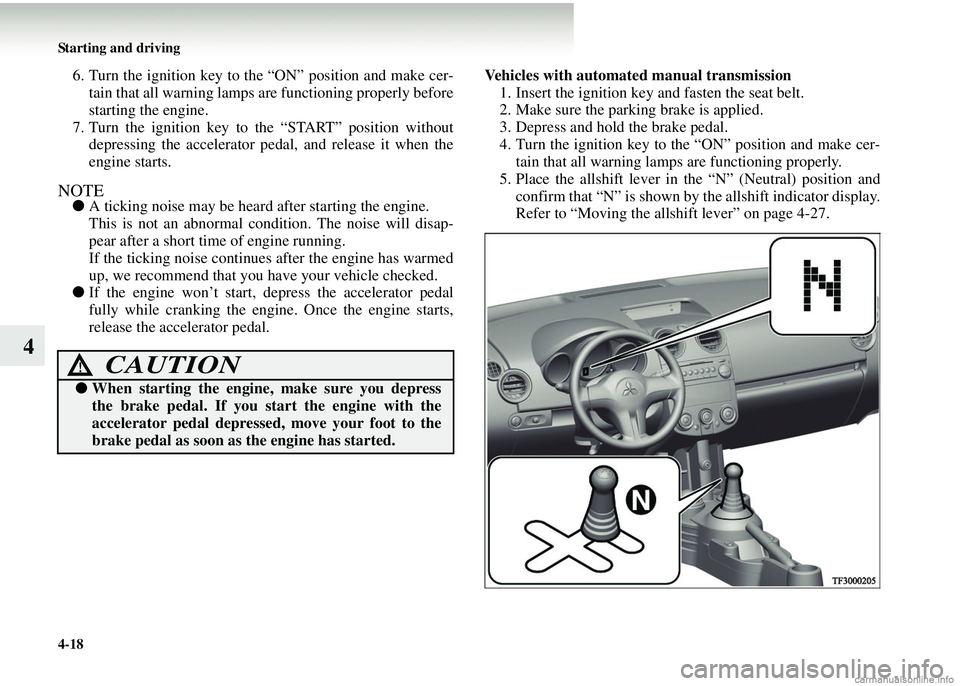
4-18 Starting and driving
4
6. Turn the ignition key to the “ON” position and make cer-tain that all warning lamps are functioning properly before
starting the engine.
7. Turn the ignition key to the “START” position without depressing the accelerator pedal, and release it when the
engine starts.
NOTE● A ticking noise may be heard after starting the engine.
This is not an abnormal condition. The noise will disap-
pear after a short time of engine running.
If the ticking noise continues after the engine has warmed
up, we recommend that you have your vehicle checked.
● If the engine won’t start, depress the accelerator pedal
fully while cranking the engi ne. Once the engine starts,
release the accelerator pedal. Vehicles with automated manual transmission
1. Insert the ignition key and fasten the seat belt.
2. Make sure the parking brake is applied.
3. Depress and hold the brake pedal.
4. Turn the ignition key to the “ON” position and make cer- tain that all warning lamps are functioning properly.
5. Place the allshift lever in the “N” (Neutral) position and confirm that “N” is shown by the allshift indicator display.
Refer to “Moving the allshift lever” on page 4-27.
CAUTION!
● When starting the engine, make sure you depress
the brake pedal. If you st art the engine with the
accelerator pedal depressed, move your foot to the
brake pedal as soon as the engine has started.
Page 185 of 450
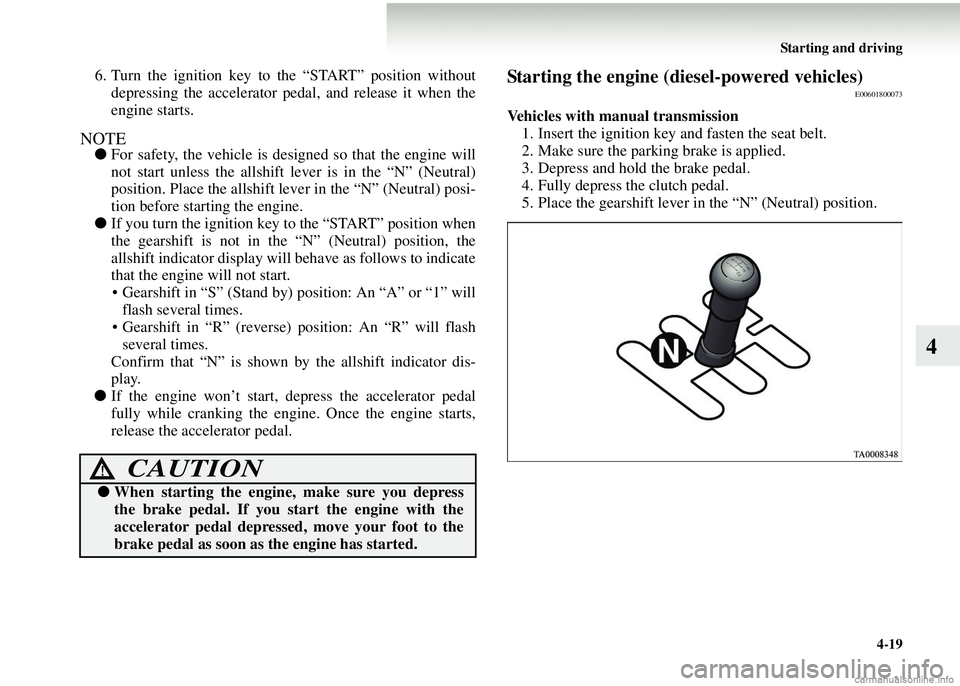
Starting and driving4-19
4
6. Turn the ignition key to the “START” position withoutdepressing the acceler ator pedal, and release it when the
engine starts.
NOTE● For safety, the vehicle is designed so that the engine will
not start unless the allshift lever is in the “N” (Neutral)
position. Place the allshift leve r in the “N” (Neutral) posi-
tion before starting the engine.
● If you turn the ignition key to the “START” position when
the gearshift is not in the “N” (Neutral) position, the
allshift indicator display will behave as follows to indicate
that the engine will not start.
• Gearshift in “S” (Stand by) position: An “A” or “1” will
flash several times.
• Gearshift in “R” (reverse) position: An “R” will flash
several times.
Confirm that “N” is shown by the allshift indicator dis-
play.
● If the engine won’t start, depress the accelerator pedal
fully while cranking the engi ne. Once the engine starts,
release the accelerator pedal.
Starting the engine (diesel-powered vehicles)E00601800073
Vehicles with manual transmission 1. Insert the ignition key and fasten the seat belt.
2. Make sure the parking brake is applied.
3. Depress and hold the brake pedal.
4. Fully depress the clutch pedal.
5. Place the gearshift lever in the “N” (Neutral) position.
CAUTION!
●When starting the engine, make sure you depress
the brake pedal. If you start the engine with the
accelerator pedal depressed, move your foot to the
brake pedal as soon as the engine has started.
Page 186 of 450
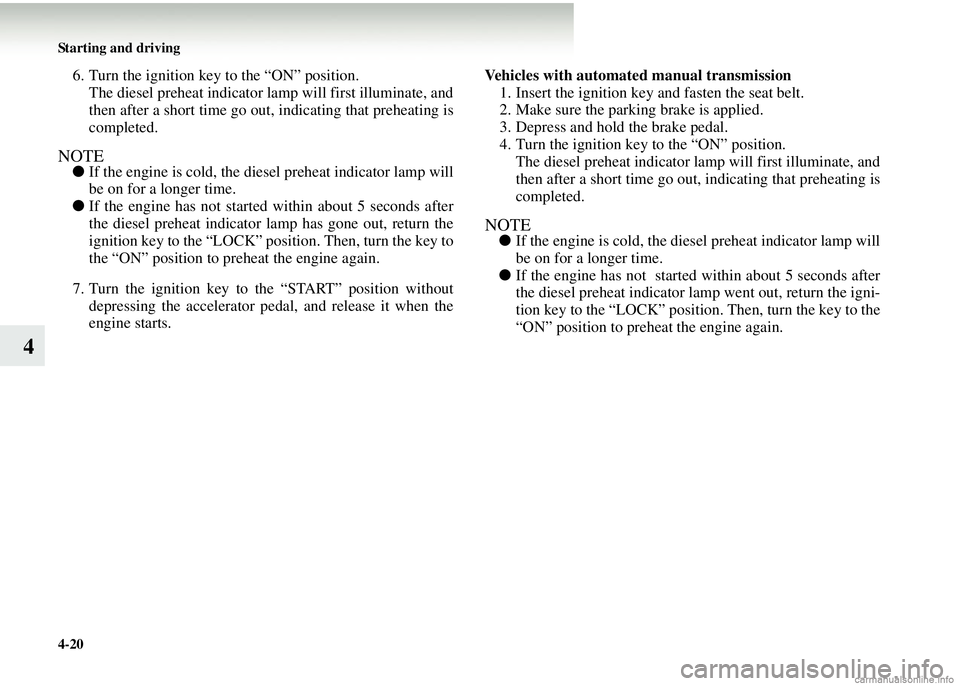
4-20 Starting and driving
4
6. Turn the ignition key to the “ON” position.The diesel preheat indicator lamp will first illuminate, and
then after a short time go out, indicating that preheating is
completed.
NOTE● If the engine is cold, the dies el preheat indicator lamp will
be on for a longer time.
● If the engine has not started within about 5 seconds after
the diesel preheat indicator lamp has gone out, return the
ignition key to the “LOCK” position. Then, turn the key to
the “ON” position to preheat the engine again.
7. Turn the ignition key to the “START” position without depressing the accelerator pedal, and release it when the
engine starts. Vehicles with automated manual transmission
1. Insert the ignition key and fasten the seat belt.
2. Make sure the parking brake is applied.
3. Depress and hold the brake pedal.
4. Turn the ignition key to the “ON” position. The diesel preheat indicator lamp will first illuminate, and
then after a short time go out, indicating that preheating is
completed.
NOTE● If the engine is cold, the dies el preheat indicator lamp will
be on for a longer time.
● If the engine has not started within about 5 seconds after
the diesel preheat indicator lamp went out, return the igni-
tion key to the “LOCK” position. Then, turn the key to the
“ON” position to preheat the engine again.
Page 187 of 450
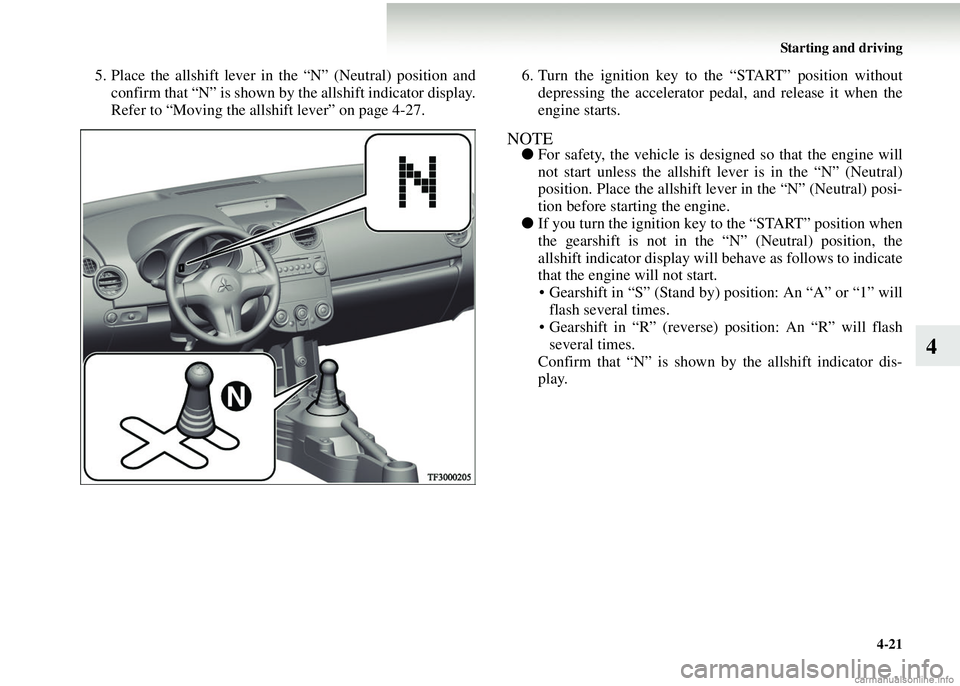
Starting and driving4-21
4
5. Place the allshift lever in the “N” (Neutral) position andconfirm that “N” is shown by the allshift indicator display.
Refer to “Moving the allshift lever” on page 4-27. 6. Turn the ignition key to the “START” position without
depressing the accelerator pedal, and release it when the
engine starts.
NOTE● For safety, the vehicle is desi gned so that the engine will
not start unless the allshift le ver is in the “N” (Neutral)
position. Place the allshift le ver in the “N” (Neutral) posi-
tion before starting the engine.
● If you turn the ignition key to the “START” position when
the gearshift is not in the “N” (Neutral) position, the
allshift indicator display will behave as follows to indicate
that the engine will not start. • Gearshift in “S” (Stand by) position: An “A” or “1” will
flash several times.
• Gearshift in “R” (reverse) position: An “R” will flash several times.
Confirm that “N” is shown by the allshift indicator dis-
play.
Page 188 of 450
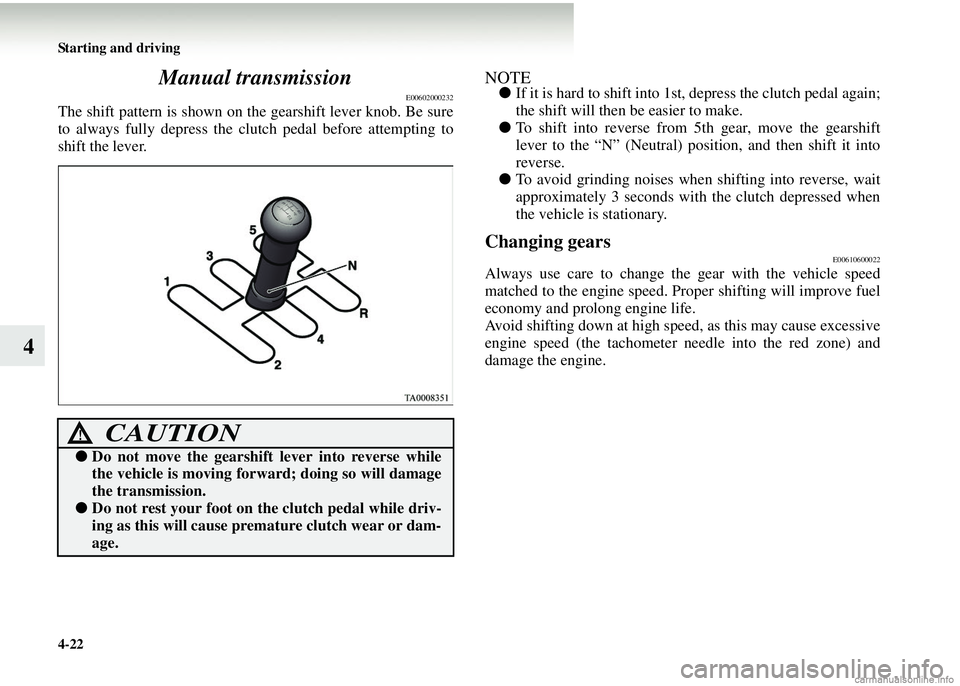
4-22 Starting and driving
4Manual transmission
E00602000232
The shift pattern is shown on the gearshift lever knob. Be sure
to always fully depress the clutch pedal before attempting to
shift the lever.
NOTE●
If it is hard to shift into 1st, depress the clutch pedal again;
the shift will then be easier to make.
● To shift into reverse from 5th gear, move the gearshift
lever to the “N” (Neutral) position, and then shift it into
reverse.
● To avoid grinding noises when shifting into reverse, wait
approximately 3 seconds with the clutch depressed when
the vehicle is stationary.
Changing gearsE00610600022
Always use care to change the gear with the vehicle speed
matched to the engine speed. Proper shifting will improve fuel
economy and prolong engine life.
Avoid shifting down at high speed, as this may cause excessive
engine speed (the tachometer needle into the red zone) and
damage the engine.
CAUTION!
● Do not move the gearshif t lever into reverse while
the vehicle is moving forward; doing so will damage
the transmission.
● Do not rest your foot on the clutch pedal while driv-
ing as this will cause prem ature clutch wear or dam-
age.
Page 189 of 450
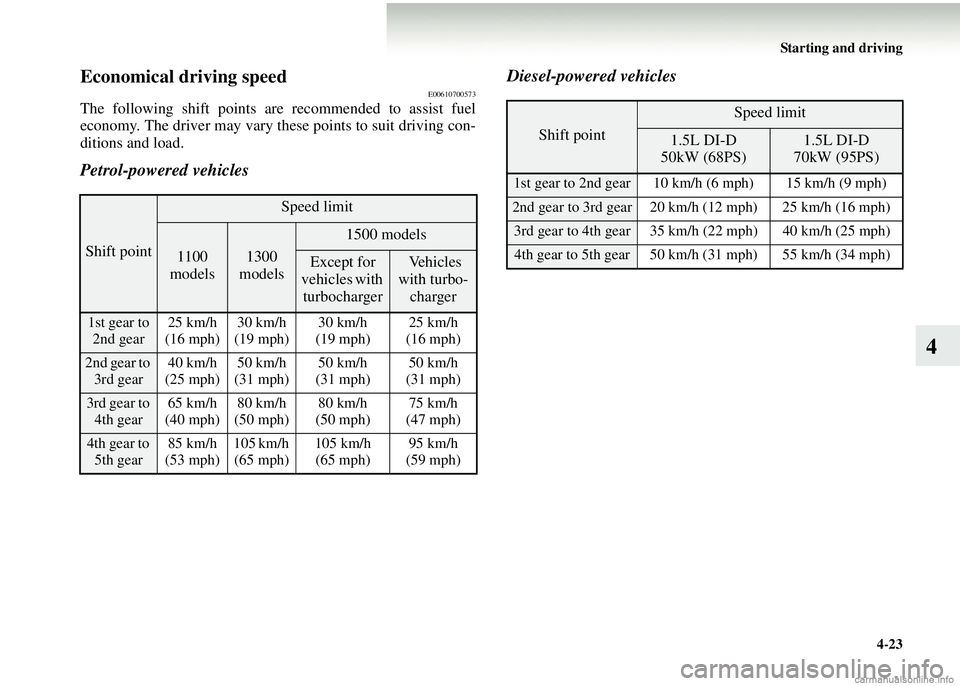
Starting and driving4-23
4
Economical driving speedE00610700573
The following shift points ar e recommended to assist fuel
economy. The driver may vary these points to suit driving con-
ditions and load.
Petrol-powered vehicles Diesel-powered vehicles
Shift point
Speed limit
1100
models1300
models
1500 models
Except for
vehicles with turbocharger Vehicles
with turbo- charger
1st gear to
2nd gear 25 km/h
(16 mph) 30 km/h
(19 mph) 30 km/h
(19 mph) 25 km/h
(16 mph)
2nd gear to 3rd gear 40 km/h
(25 mph) 50 km/h
(31 mph) 50 km/h
(31 mph) 50 km/h
(31 mph)
3rd gear to 4th gear 65 km/h
(40 mph) 80 km/h
(50 mph) 80 km/h
(50 mph) 75 km/h
(47 mph)
4th gear to 5th gear 85 km/h
(53 mph) 105 km/h
(65 mph) 105 km/h
(65 mph) 95 km/h
(59 mph)
Shift point
Speed limit
1.5L DI-D
50kW (68PS)1.5L DI-D
70kW (95PS)
1st gear to 2nd gear 10 km/h (6 mph) 15 km/h (9 mph)
2nd gear to 3rd gear 20 km/h (12 mph) 25 km/h (16 mph)
3rd gear to 4th gear 35 km/h (22 mph) 40 km/h (25 mph)
4th gear to 5th gear 50 km/h (31 mph) 55 km/h (34 mph)
Page 190 of 450
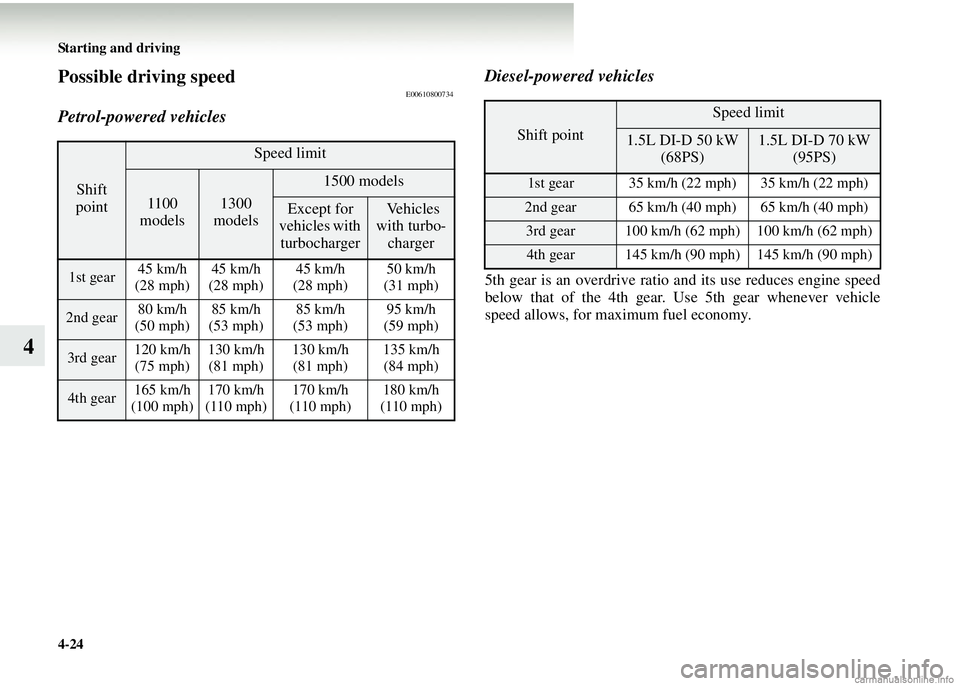
4-24 Starting and driving
4
Possible driving speedE00610800734
Petrol-powered vehiclesDiesel-powered vehicles
5th gear is an overdrive ratio and its use reduces engine speed
below that of the 4th gear. Us
e 5th gear whenever vehicle
speed allows, for maximum fuel economy.
Shift
point
Speed limit
1100
models1300
models
1500 models
Except for
vehicles with turbocharger Vehicles
with turbo- charger
1st gear 45 km/h
(28 mph) 45 km/h
(28 mph) 45 km/h
(28 mph) 50 km/h
(31 mph)
2nd gear 80 km/h
(50 mph) 85 km/h
(53 mph) 85 km/h
(53 mph) 95 km/h
(59 mph)
3rd gear 120 km/h
(75 mph) 130 km/h
(81 mph) 130 km/h
(81 mph) 135 km/h
(84 mph)
4th gear 165 km/h
(100 mph) 170 km/h
(110 mph) 170 km/h
(110 mph) 180 km/h
(110 mph)
Shift point
Speed limit
1.5L DI-D 50 kW (68PS)1.5L DI-D 70 kW (95PS)
1st gear 35 km/h (22 mph) 35 km/h (22 mph)
2nd gear 65 km/h (40 mph) 65 km/h (40 mph)
3rd gear 100 km/h (62 mph) 100 km/h (62 mph)
4th gear 145 km/h (90 mph) 145 km/h (90 mph)